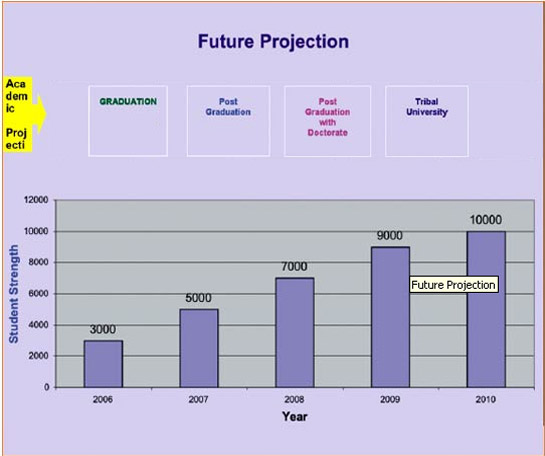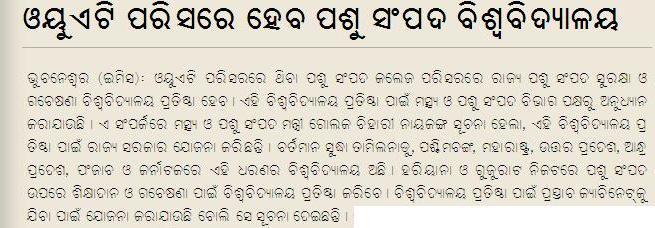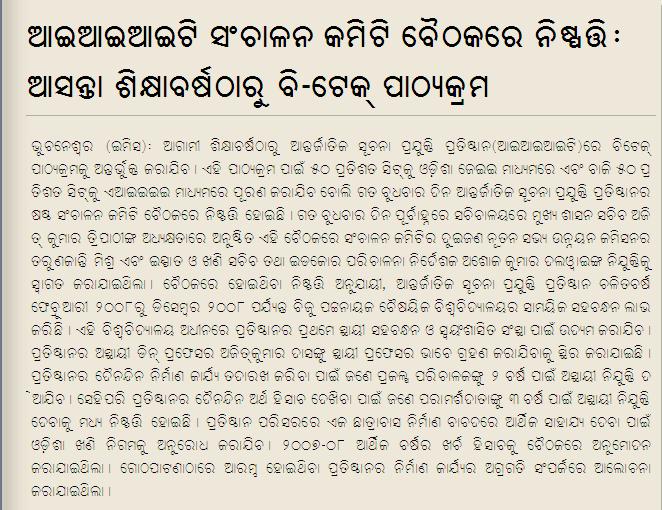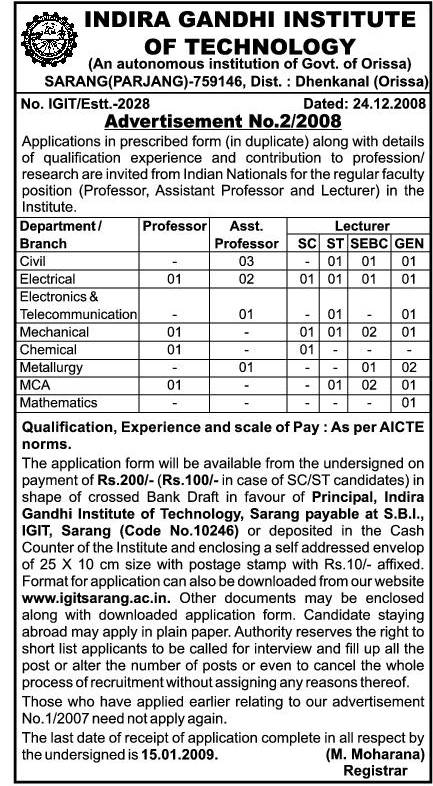Its web page is http://www.indianarmy.gov.in/aad/indexmain.html. Following are some excerpts from that page.
History:
The Army Air Defence College has an illustrious history dating back to pre independence era, when the School of Artillery was located at Quetta and the Anti Aircraft Wing was located at Karachi. When India gained Independence 1947, the School of Artillery and the Anti Aircraft Wing moved to Deolali. The Anti Aircraft Wing was renamed as the Air Defence Wing and was placed under School of Artillery.
In 1955 a case was taken up to relocate Air Defence Wing from Deolali, due to lack of adequate ranges for gun and missile firing. In 1963, the Government of Orissa offered 3000 acres of land at Gopalpur -On –Sea, along with seaward firing range, which was accepted in 1968. In 1979, Government of India sanctioned the establishment of Air Defence and Guided Missile School and Centre at Gopalpur – On – Sea. Gopalpur Cantonment was inaugurated on 30 October 1984 by late Shrimati Indira Gandhi, the Prime Minister of India.
January 9th, 2009
Author : Chitta Baral
Following is an excerpt from a report in Indopia.
Domestic steel producer Jindal Steel and Power has invested about Rs 300 crore to set a law school as part of its O P Jindal Global University project and will also approach corporate houses like Tatas and Ambanis to pump in more funds in the form of endowments.
The college, envisioned by JSPL Executive Vice-Chairman and Managing Director Navin Jindal, has been at the university campus in Sonepat, Haryana. The first session of the college, is expected to start in September this year.
" Jindal Global Law School will be the first phase of our endevour to promote excellence in higher education by setting up O P Jindal Global University. We have infused up to Rs 300 crore at the moment and expect more investment in form of endowments and donations," O P Jindal Global University Professor and CEO C Raj Kumar told media.
…The law college would function in collaboration with the top institutes worldwide like Harvard Law School among others and would offer a three-year post-graduate LLB programme. The institute is also planning to commence a five-year undergraduate programme in law.
Kumar said school would have competitive fee structure of Rs six lakh per annum and would offer scholarship and easy loan schemes to them.
The Orissa government should push JSPL for setting up similar higher education institutions in Orissa where they have existing operations (such as an iron ore mine in Tensa, Keonjhar) and where they are expanding some operations. In particular:
January 9th, 2009
Author : Chitta Baral
Silicon Institute of Technology, perhaps the best private engineering college under BPUT and among the top 5 engineering colleges under BPUT is making a campus in Sambalpur that is expected to start in 2009. It will be most likely called as: Silicon Institute of Technology, Sambalpur.
This campus will be located few kms away from Sambalpur on the Sambalpur-Jharsuguda highway.
This campus will have some of the the traditional branches, such as Civil Engineering, which are not there in the Bhubaneswar campus.
January 9th, 2009
Author : Chitta Baral
Following is from http://pib.nic.in/release/release.asp?relid=46323.
The Cabinet Committee on Economic Affairs today gave its approval for a new Centrally sponsored Scheme by the name of National Mission on Education through Information and Communication Technology (ICT) submitted by the Ministry of HRD.
An amount of Rs.4612 crore is to be incurred during the 11th Five Year Plan for the National Mission on Education through ICT. There is a budget provision of Rs.502 crore during the current financial year 2008-09.
The National Mission on Education through ICT has been envisaged as a Centrally sponsored Scheme to leverage the potential of ICT, in providing high quality personalized and interactive knowledge modules over the internet/intranet for all the learners in Higher Education Institutions in any time any where mode. This is expected to be a major intervention in enhancing the Gross Enrolment Ratio (GER) in Higher Education by 5 percentage points during the XI Five year Plan period and in ensuring access and equity in Higher Education, as also recommended by the Oversight Committee and the National Knowledge Commission. The Mission has two major components viz., (a) content generation and (b) connectivity along with provision for access devices for institutions and learners. It seeks to bridge the digital divide, i.e. the gap in the skills to use computing devices for the purpose of teaching and learning among urban and rural teachers/learners in Higher Education domain and empower those, who have hitherto remained untouched by the digital revolution and have not been able to joint the mainstream of the knowledge economy. It plans to focus on appropriate pedagogy for e-learning, providing facility of performing experiments through virtual laboratories, on-line testing and certification, on-line availability of teachers to guide and mentor learners, utilization of available Education Satellite (EduSAT) and Direct to Home (DTH) platform, training and empowerment of teachers to effectively use the new method of teaching learning etc.
The Mission shall work in close cooperation and collaboration with other Missions/Schemes such as the National Translation Mission, Vocational Education Mission, National Knowledge Network, Scheme of ICT @ Schools etc., to avoid any duplication and attain synergy. It would operate through inter-departmental and multi-disciplinary approach. On the one hand, the Mission would create high quality e-content for the target groups and on the other, it would simultaneously extend computer infrastructure and connectivity to over 18000 colleges in the country including each of the departments of 419 universities/deemed universities and institutions of national importance on a single point rental basis through the Department of Telecommunications (DOT), in a manner that would permit their seamless interaction with a integrated National Knowledge Network. The advent of very low-cost-low-power consuming access cum computing devices, would further enhance the reach of the network. The peer group assisted content development would utilise the wikipaedia type of collaborative platform under the supervision of a content advisory committee responsible for vetting the content. Interactivity and problem solving approach would be addressed through “Talk to a Teacher” segment. The Mission would also have a component of Teacher Empowerment through proper training and digital literacy of teachers to be able to use the e-contents. Renowned institutions would anchor various activities in their areas of excellence. The Mission would seek to enhance the standards of education, in Government as well as in private colleges. Enlistment of support and cooperation of States/Union Territories, Institutions and individual experts would be an integral part of the Mission.
The Mission will ensure that there is no duplication with National Knowledge Network. It will also cater to contents for higher education sector. National Programme of Technology enhanced Learning (NPTEL) Phase II and III will be part of the generation activity.
The Mission would have a three tier committee system to monitor and guide its functioning. The apex National Committee would be chaired by Hon’ble Minister of Human Resource Development. It would decide on all policy and administrative issues and prescribe guidelines for the functioning of the two sets of Committees namely ‘Empowered Committee of Experts (henceforth shall be called as ‘Project Approval Board’) would be sanctioning individual projects and monitoring the overall progress through various peer reviews and concurrent evaluation.
Ministry of HRD, Deptt. of Higher Education would enter into MoU with State Governments for proper monitoring of the Scheme in their State and contribute 50% of the cost of hardware and 25% of the cost of connectivity in respect of the colleges/institutions/universities maintained or substantially funded by it. Similar MoU would also be entered into with Mentor institutions for private/self-financing colleges/institutions/universities for ensuring that the beneficiary institutions contribute 50% of the cost of hardware and 25% of the cost of connectivity and maintain and sustain the facility created under the Scheme after expire of 5 years.
The projected benefits/results of the Scheme would be enhancement of access to quality education, making available knowledge modules in cyber space and optimal utilization of available resources by using of ICT for educating the masses, especially those inhibited in remotely located areas and places at disadvantage.
*****
AD/SH/LV
January 3rd, 2009
Author : Chitta Baral
Following is from http://pib.nic.in/release/release.asp?relid=46321.
The CCEA today approved the implementation of a centrally sponsored scheme to universalise access to and improve quality of education at Secondary stage, called Rashtriya Madhyamik Shiksha Abhiyan (RMSA) during the 11th Five Year Plan.
As regards the Financing pattern and fund flow, Union Government shall bear 75% of the project expenditure during the 11th Five Year Plan, with 25% of the cost to be borne by State Governments. Sharing pattern will be 50:50 for the 12th five year plan. For both the 11th and 12th Plans, funding pattern will be 90:10 for North Eastern States. Rs.20,120 crore has been allocated for the Scheme during the 11th Five Year Plan.
The objective of the Scheme is:
• to achieve a General Enrolment Ratio (GER) of 75% for classes IX-X within 5 years by providing a secondary school within a reasonable distance of every habitation;
• to improve quality of education imparted at secondary level through making all secondary schools conform to prescribed norms;
• to remove gender, socio-economic and disability barriers, Universal access to secondary level education by 2017, i.e. by the end of 12th Five Year Plan and Universal retention by 2020.
Broad physical targets include improving the enrolment ratio for classes IX-X to 75% within 5 years from 52.26% as in 2005-06, providing facilities for estimated additional enrolment of 32.20 lakh by 2011-12 through, strengthening of about 44,000 existing secondary schools, opening 11,188 new secondary schools, appointment of 1.79 lakh additional teachers and construction of 80,500 additional classrooms.
Interventions approved include providing infrastructure in schools such as new classrooms with furniture, library, science laboratory, computer room, disabled friendly provisions etc, recruitment of additional teachers with emphasis on Science, Mathematics and English teachers, in service training of teachers, teaching aids such as ICT and special focus on SC/ST/Minorities Girls. Steps such as priority for opening or upgradation of schools in areas of SC/ST/minority/weaker section concentration and enrolment drives and special coaching classes in those areas are also envisaged under the scheme.
The Scheme will be implemented in a Mission mode, with a National Mission headed by the Union Minister for HRD and a Project approval Board headed by Secretary (School Education and Literacy) to appraise and approve state plans. Similarly, State Missions under Chief Ministers of the States/UTs will be set up.
The Scheme envisages development of State-specific norms and District will be the unit of planning. The district plan will be appraised and consolidated at the State level and the State plan will be appraised by the technical support group attached to the National Mission. The civil construction will be through School Management and Development Committee with representation from parents, Panchayati Raj Institutions and civil society.
*****
AD/SH/LV
January 3rd, 2009
Author : Chitta Baral
KISS plans to become a tribal university in 2009-2010. See http://kissorissa.org/website/about-us.htm. Following is a table from that page.

January 2nd, 2009
Author : Chitta Baral

January 2nd, 2009
Author : Chitta Baral
Following is from http://pib.nic.in/release/release.asp?relid=46293.
DEPTT. OF SCIENCE AND TECHNOLOGY
Department of Science & Technology initiated several easy to access programmes for people. Following are some of the highlights:
Innovation in Science Pursuit for Inspire Research (INSPIRE)
INSPIRE is a programme by the Department of Science & Technology for attraction of talent to study science and careers with research. The Scheme includes three sub-components namely a) Scheme for Early Attraction of Talents for Science (SEATS), b) Scholarship for Higher Education (SHE) and c) Assured Opportunity for Research Careers (AORC).
Scheme for Early Attraction of Talent (SEATS) aims to attract talented youth to study science through INSPIRE award of Rs 5000 to each awardee. About one million young learners of the age group 10-15 years will be selected fro INSPIRE Award from the toppers who constitute approximately one percent in the Class X Board examinations in the country. Summer camps for about 50,000 youth will be organised in which students will interact with global science leaders..
Scholarship for Higher Education (SHE) aims to enhance rates of attachment of talented youth to higher education in science intensive programmes. The scheme offers 10,000 scholarship and mentorship every year @ Rs 0.80 lakh per year for undertaking Bachelor and Masters level education in natural sciences. A main feature of the scheme is in mentorship support for every scholar through INSPIRE scholarship.
Assured Opportunity for Research Careers (AORC) aims to attract, attach, retain and nourish talented young scientific Human Resource for strengthening the R&D foundation and base by offering doctoral INSPIRE fellowship in the age group of 22-27 in the both basic and applied sciences including engineering and medicine and assured opportunity for post doctoral researchers in the age group of 27-32 years through contractual and tenure track positions for 5 years in both basic and applied sciences areas through an INSPIRE faculty scheme.
Science & Engineering Research Board (SERB)
SERB is an autonomous empowered Board to be established through an Act of Parliament. It will promote excellence in research through established groups pursuing advanced research and gaining global competitiveness for Indian Science and strive to de-bureaucratize the funding support system. The Parliament has passed the bill on the formation of SERB.
Nano Mission
India has mounted a national nano mission in 2007 with an objective of promoting basic and applied research in nano science with an outlay of Rs 1000 crores over 5 years. Under this mission, a new Institute of nano science and technology at Mohali and centers of Banglore and Kolkata are being established. Projects and centres of excellence in basic and applied research have been supported with an outlay of over Rs 150 crores during 2007-08. More than 500 students are currently carrying out doctoral research in nano science in the country.
Initiative for Technologies for Safe Drinking Water
The department has mounted a national initiative to assess technologies and products available for providing safe drinking water for decentralized use and create a data base of technologies after the evaluation of field performance of products and technologies.
Recent Success Stories of the incubated companies promoted by NSTEDB, DSTsupported Technology Business Incubator (TBI).
Torque 360 Degree Solutions is an incubated company of Technopark, Trivandrum which specializes in providing wireless messaging solutions enabling direct communication with targeted audiences and service them through various messaging products and tools. One of its spin off, MobME , Mobile Media and Entertainment Start-up is valued at US $ 7 Million and is listed on top 100 IT Innovators 2007 by NASSCOM.
Laurus Laboratories nurtured in ICICI Knowledge Park, Hyderabad, life science Incubator functions in the area of pharmaceutical process development which provides integrated services, technologies and manufacturing capabilities spanning the entire drug development life cycle, have had an iconic growth with over USD 100 million valuation and a strategic partnership with Aptuit Inc. in less than two years and created 425 scientist level jobs and around 100 support level jobs.
SooryaKiran Bioinformatics (P) Ltd is a university incubated, new generation bioinformatics company functioning from Technopark, Trivandrum provides reliable, cost effective, world-class customized solutions that bridge the gap between information analysis and knowledge management. The company is poised to establish itself as a world renowned organization, striving to set benchmarks in Computational Biology and Bioinformatic.
National Mission on Bamboo Applications
National Mission on Bamboo Applications focused attention on value addition of bamboo materials through applications of technology and product development in area of structural materials and energy generation. Several housing and structural applications related technologies have been commercialized.
DRUGS AND PHARMACEUTICAL RESEARCH PROGRAM
The programme has established a number of Public Private Partnerships (PPP) in drug development. Total of 85 collaborative R&D projects with leading industries, 31 national facilities and 37 Pharma Industry loan projects have been supported.
The programme has resulted in filing 15 product patents and 13 process patents. Industrial leads on Psoriasis, Migraine, Malaria, Anti-Glaucoma, Chronic Obstructive Pulmonary Disease, Diabetes, aging, Pancreatic Cancer, Osteoporosis are under different phases (Phase I, II, III) clinical trials.
Science Express – an innovative science exhibition on-wheels
Science Express’, an innovative Indo-German Pathway to Discovery, is a unique science exhibition-on-wheels. It was flagged off by Hon’ble Prime Minister of India Dr. Manmohan Singh and Federal Chancellor of Germany Dr. Angela Merkel from Delhi Safdarjung on 30 October 2007. It is a joint venture between the Max Planck Society Germany (MPS), a Noble laureate powerhouse and Department of Science & Technology (DST), Government of India, with the support of Germany’s Federal Ministry of Education and Research (BMBF) and the German corporate giant BASF and its Indian arm, among others. The exhibition comprising of over 350 interactive displays, large format modules, video clips and voice-overs strived to provide insights into some most pressing questions about evolution besides state-of-the-art of several scientific pursuits. It also hosted world famous Kids’ Lab of BASF and over 15,000 students performed interesting experiments in Chemistry.
During its incredible tour of India to 57 locations in 217 days covering over 15,000 kms during, this first-of-its kind exhibition received overwhelming response at each halt as it attracted over 22.5 lakhs visitors. Buoyed by its success, a modified version called ‘sciencexpress’ having more indigenous content has been launched on 30 November 2008 to another 50 destinations not covered earlier.
International S&T Cooperation
The Department of Science and Technology on behalf of the Government of India has enlarged the Scope and strength of S&T cooperation with many countries during the year 2008-09. Stepped cooperation with European Union, United Kingdom, Germany, Japan, Australia, Canada, Israel, Russia, SAARC, brazil, South Africa formed special focus during 2008-09. Indian beam line in Japan, Science express with Germany, Industrial R&D fund support with Israel and Canada, science bridges with UK, Joint Biomedical center with Russia, coordinated call for research on computational material science with EU are some indications of stepped up S&T cooperation registered during 2008-09.
PRA/SKK
January 2nd, 2009
Author : Chitta Baral
Following is an excerpt from a report in Indian Express.
First private university
The state may also see its first private university in the new year, with the assembly passing the Dhirubhai Ambani Institute of Information and Communication Technology Bill. This marks a major policy shift for the Left Front government, which has been rallying against input of private capital in education. The institute, which involves an investment of Rs 100 crore, has been designated a 50-acre plot in Kalyani.
Central status for BESU
Come 2009 and the 150-year-old varsity is expecting to be conferred the status of an Indian Institute of Engineering Science and Technology (IIEST). The state government is putting all its weight behind BESU to see that it becomes the first such institute in the country. The university has submitted a fresh plan for its spending, but with new IITs and central universities high on the agenda of the Union Ministry for Human Resources Development, the IIEST status for BESU has taken a backseat.
January 1st, 2009
Author : Chitta Baral
He was previously at the MHRD. See here.
Bata Kishore Ray/
(Asst Financial Adviser) |
234-C Shastri BhavanDr. Rajendra Prasad RoadDelhi
Pin: – 110001
Tel: – 23388608Fax: – 23388608
Category – Central Secretariat Services
Organisation – Ministry of Human Resource Development
Email – bkray@nic.in |
January 1st, 2009
Author : Chitta Baral
Following is an excerpt from a report in expressbuz.com.
Union Minister of State for Coal Santosh Bagrodia today said small and medium-scale industries and coal-based power plants will be supplied coal as per necessity.
Addressing newsmen here, the Minister maintained that there is no shortage of coal in the country.
… Mahanadi Coalfields Limited (MCL) would adopt two ITIs and set up a medical college at Talcher.The medical college will be set up before the new academic session. The Minister informed the Chief Minister about these decisions.
December 29th, 2008
Author : Chitta Baral
Following is an excerpt from a report in tathya.in.
… The Chief Minister decided to assuage the hurt feelings of the people of Kalahandi by announcing two professional colleges in the district.
Mr.Patnaik chairing the high level meeting here on 27 December announced to set up an engineering and a new agriculture college at Bhawanipatna.
…Sensing the popular demand for more educational facilities in the district, Mr.Patnaik declared that “there will be an agriculture and engineering college at Bhawanipatna”.
Funds will be located from Special Problem Fund (SPF) for both these institutions.
Both the colleges were provided Rs.5 crore each to take up preliminary works.
The engineering college will have 240 seats, where as the agriculture college will accommodate 48 students, revealed an official.
There are 63 engineering colleges, where as this will be the third agriculture college in the state, said he.
Two agriculture colleges exist at Bhubaneswar in Khurda district and Chiplima in Sambalpur district.
The College of Agriculture, Bhawanipatna will be under the Orissa University of Agriculture Technology (OUAT).
… Mr.Patnaik also asked Dr.Arabinda Padhee, Director Agriculture to take up the matter with VC OUAT for facilitating the students to enroll them in 2009-10.
Dr.Padhee gave out details on the planning process on establishing the new institution.
Tarun Kanti Mishra, Development Commissioner who attended the meeting will co-ordinate the land alienation and construction work in a faster manner.
December 28th, 2008
Author : Chitta Baral
I hope it is in the KBK+Gajapati+Kandhamala region. See http://www.tathya.in/2008/index.asp.
December 27th, 2008
Author : Chitta Baral

December 26th, 2008
Author : Chitta Baral

December 26th, 2008
Author : Chitta Baral
Update: Excerpts from a report in Kalinga Times.
Aragul near Jatni has been finally chosen as the place for setting up of the Indian Institute of Technology, Bhubaneswar.
A four-member Central team sent by the Union Ministry of Human Resource Development selected Aragul after visiting four different places.
The team comprised Ashok Thakur, Additional Secretary in the Union Ministry of Human Resource Development; Damodar Acharya, Director of IIT Kharagpur; A.K. Dey, former Director of IIT Mumbai; and K. Narayan Rao, Secretary of All-India Council for Technical Education (AICTE).
The place selected is 12 km from Bhubaneswar airport by road and four km away from Jatni railway junction.
Following are excerpts from a report in tathya.in.
Ashok Thakur is impressed with Argul.
The Chairman of the Site Selection Committee for the IIT-Bhubaneswar found the site near Jatni a ‘nice’ one.
… The State Government has identified Argul near Jatni and Malipada near Khurda.
Both are in Khurda district.
Secondly Ramdaspur near Naraj and Dampada near Banki in Cuttack district were also identified for the purpose.
Mr.Thakur himself visited Argul on 25 December and expressed satisfaction over the place, said sources.
It is 891 acre of land out of which 500 acres are readily available.
Very near to the Capital city and well connected with rail and road.
Institutions like NISER, various engineering colleges and other institutions are coming up in the near by area.
This place was favored by the State Government for the IIT-Bh as the most suitable one.
It looks very likely that Argul will be chosen for the IIT site. But the others sites would soon come into play; especially for the world class central university (national university).
December 25th, 2008
Author : Chitta Baral
Next Posts
Previous Posts




